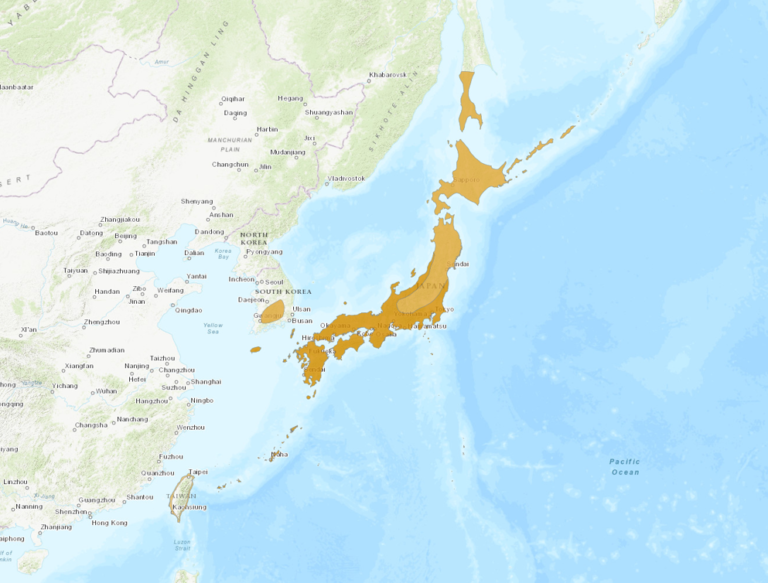Birdfinding.info ⇒ Generally common across much of Japan, including Tokyo city parks that have adequate cover. When singing, it is usually conspicuous at several touristic sites including Mount Fuji and the gardens of Kyoto. Localized island populations are common on Miyake and Okinawa (e.g., Benoki and Fungawa Dams). In Hawaii, it is one of the commonest birds in brushy habitat, especially in areas that have lost all native songbirds, such as Lana’ihale on Lanai. Ubiquitous in brushy areas on Oahu, Kauai, and Molokai. On Maui it can be found at Polipoli Spring and Haleakala National Park, and on the Big Island at Kaloko Mauka, Pu’u La’au, and Hawaii Volcanoes National Park.
Japanese Bush-Warbler
Horornis diphone
Family: Cettiidae
Japan, Korea, and neighboring islands; introduced to Hawaii. Inhabits forest undergrowth and brushy areas, where it remains hidden most of the time.
The full extent of its range is obscured by confusion over subspecies and species limits. Some populations are resident and some migrate either short or long distances.
There are two widespread subspecies and two (or possibly more) that are localized:
Cantans is mostly resident on Honshu, Kyushu, Shikoku, and smaller adjacent islands; including Jeju Island, South Korea.
Riukiuensis is migratory: breeding on Sakhalin, the southern Kurile Islands, Hokkaido, and possibly the Korean Peninsula; and wintering mainly in southern Japan (including the Ryukyu Islands) and Taiwan, with an unknown portion wintering along the Chinese coast.
Several populations are resident on more isolated islands of the archipelago, including diphone, which is attributed to the Izu, Ogasawara, and Iwo Islands, and restrictus, formerly attributed to the tiny, remote, mid-oceanic Daito Islands, but now regarded as restricted to Okinawa. On geographical grounds, each of these probably reflects an island-specific colonization pattern from the larger populations.
Some of the local resident populations are regarded as vocally distinct enough to be recognized as separate species. These include the populations on Okinawa, Tokara (northern Ryukyus), and formerly the Daito Islands.
A few hundred individuals (presumably cantans) were introduced to Oahu between 1929 and 1941 as an insect control measure. During the 1970s and ’80s their descendants colonized the nearby islands and by the 2010s were well established and numerous from Kauai to the Big Island.
Identification
A secretive, mostly brown warbler with a pronounced dark eyeline and pale eyebrow, proportionately long tail, and pink legs.
Depending on age and feather-wear, its coloration varies from cold-brown above and whitish-gray below to rusty-brown above and yellowish or buffy below.
On the upperparts, often shows contrastingly rusty highlights in the wings, tail, and forecrown.
On the underparts, usually appears whitest on the throat and grayer on the breast and belly, usually with at least a buffy or yellowish wash on the undertail coverts, flanks, and mid-belly.
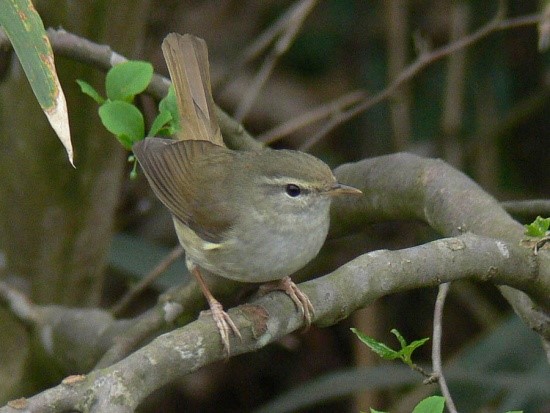
Japanese Bush-Warbler, showing typically drab coloration with somewhat warmer tail. (Japan; April 16, 2007.) © petitebouquet

Japanese Bush-Warbler, showing contrasting rusty highlights on the wings, tail, and forecrown. (Fungawa Dam, Okinawa, Japan; December 10, 2013.) © Ian Davies

Japanese Bush-Warbler, H. d. riukiuensis, showing contrasting rusty highlights on the wings, tail, and forecrown, and a buffy wash on the belly. (Mount Hakodate, Hokkaido, Japan; May 4, 2018.) © Rick Taylor

Japanese Bush-Warbler, singing and showing warm-brown highlights on wings and tail. (Aichi, Honshu, Japan; March 22, 2014.) © Alpsdake

Japanese Bush-Warbler, H. d. diphone. (Haha-jima, Ogasawara Islands, Japan; May 28, 2017.) © Lars Petersson
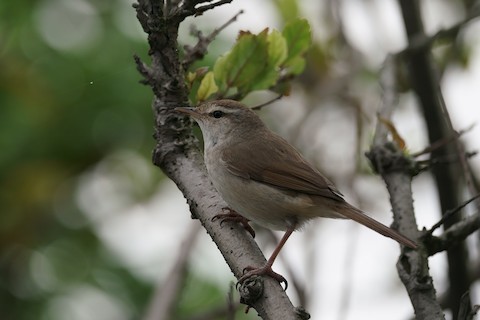
Japanese Bush-Warbler, H. d. riukiuensis, showing typically drab coloration. (Dayuan Litcuo, Taoyuan, Taiwan; March 18, 2020.) © Teng-Hung Lin
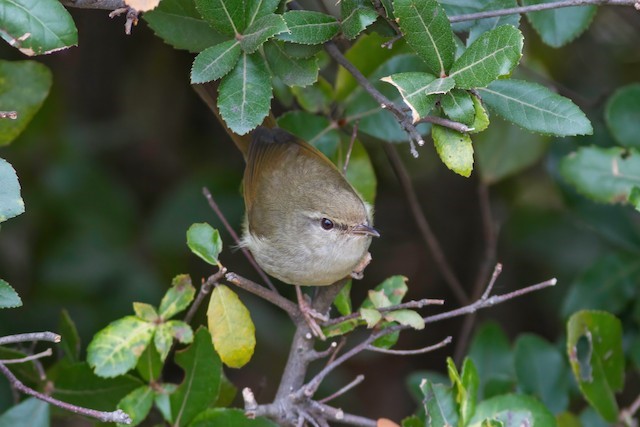
Japanese Bush-Warbler, H. d. cantans. (Osaka, Japan; February 8, 2020.) © Paul Hyde
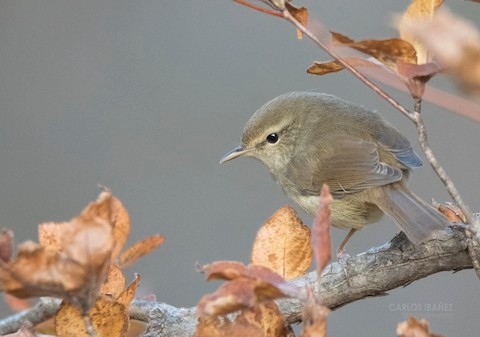
Japanese Bush-Warbler, showing generally cold-brown upperparts. (Nikko, Tochigi, Honshu, Japan; November 9, 2019.) © Carlos Ibañez

Japanese Bush-Warbler, H. d. cantans, showing all-gray underparts with paler throat and darker chest. (Kilauea Point National Wildlife Refuge, Kauai, Hawaii; March 10, 2007.) © Michael Walther
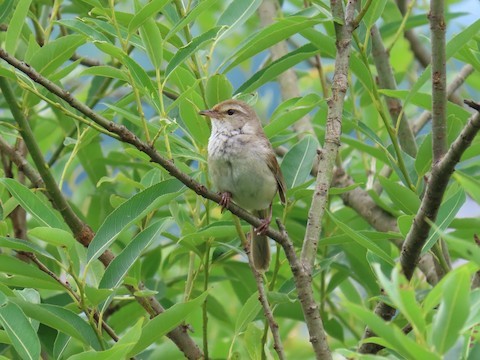
Japanese Bush-Warbler, H. d. cantans, showing all-gray underparts. (Oishi Park, Lake Kawaguchi, Yamanashi, Honshu, Japan; July 16, 2019.) © William Legge
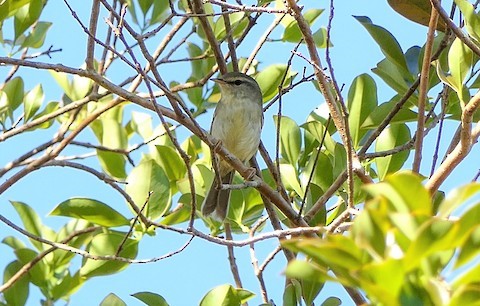
Japanese Bush-Warbler, H. d. cantans, appearing drab overall with a yellowish wash on the belly. (Hanalei National Wildlife Refuge, Kauai, Hawaii; April 6, 2019.) © Randall Siebert

Japanese Bush-Warbler, H. d. cantans, singing and showing all-gray underparts with paler throat and darker chest. (Kilauea Point National Wildlife Refuge, Kauai, Hawaii; March 10, 2007.) © Michael Walther

Japanese Bush-Warbler, H. d. cantans, appearing mostly gray above and below. (Alakai Swamp Trail, Kauai, Hawaii; May 14, 2019.) © Michael Woodruff

Japanese Bush-Warbler, showing a slight buffy wash on its grayish underparts. (Oeyeon Island, South Korea; April 29, 2018.) © Todd Hull

Japanese Bush-Warbler, H. d. cantans, showing warm-brown highlights and buffy flanks. (Beppu, Oita, Kyushu, Japan; December 5, 2009.) © Ayuwat Jearwattanakanok
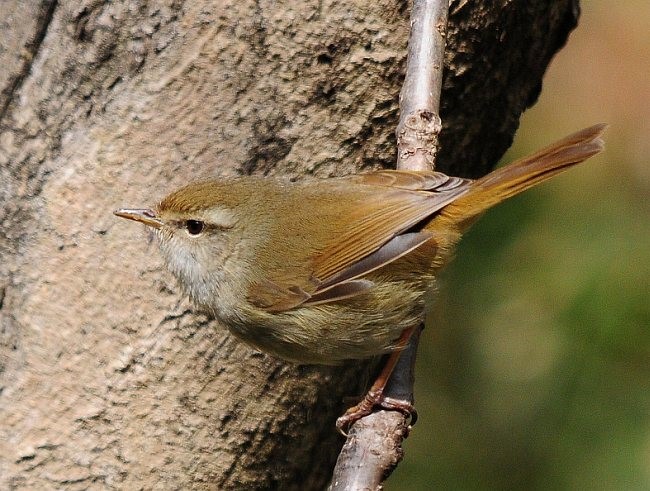
Japanese Bush-Warbler, H. d. cantans, showing warm-brown highlights and buffy flanks. (Maioka Koen, Yokohama, Honshu, Japan; February 19, 2012.) © Koji Tagi
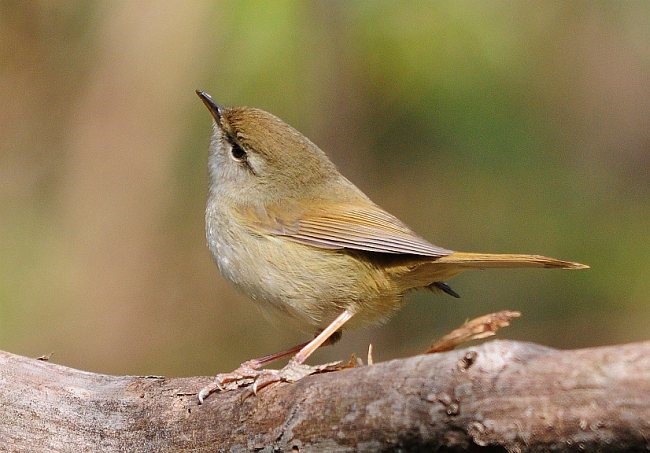
Japanese Bush-Warbler, H. d. cantans, showing warm-brown highlights and buffy flanks. (Maioka Koen, Yokohama, Honshu, Japan; February 19, 2012.) © Koji Tagi
Immatures and adults during fall and winter are often much brighter overall: rustier above and yellower or buffier below.
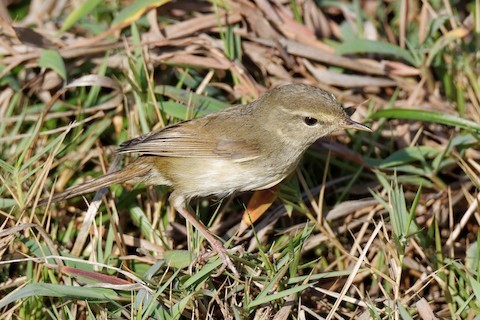
Japanese Bush-Warbler, H. d. riukiuensis, showing generally drab plumage with strong rusty wash on the flanks and buffy eyebrow. (Yeliu, Taipei, Taiwan; November 23, 2014.) © H Chen-Cheng

Japanese Bush-Warbler, H. d. cantans, showing warm-brown highlights and buffy flanks. (Kasai Kaihin Park, Tokyo, Japan; February 27, 2017.) © Yoshio Akasaka
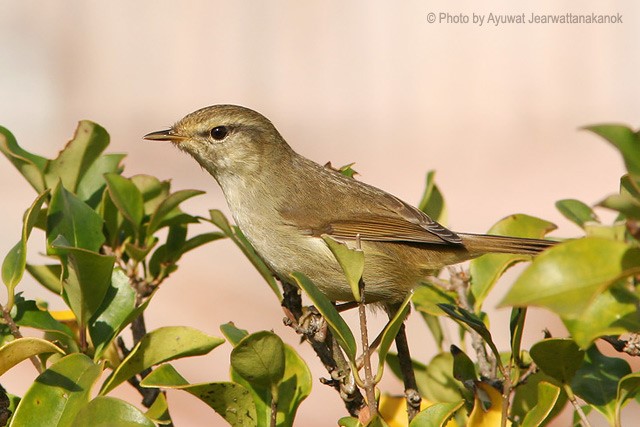
Japanese Bush-Warbler, H. d. cantans, appearing mostly gray-brown. (Beppu, Oita, Kyushu, Japan; December 5, 2009.) © Ayuwat Jearwattanakanok
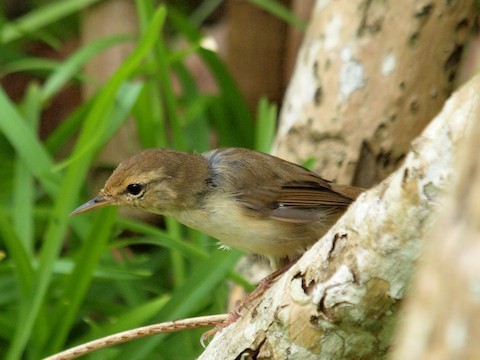
Japanese Bush-Warbler, immature showing patchy yellowish or buffy wash on face and underparts. (Chichijima, Tokyo, Japan; September 15, 2013.) © Atsushi Shimazaki

Japanese Bush-Warbler, immature—note partly grown outer tail feathers. (Chichijima, Tokyo, Japan; September 15, 2013.) © Atsushi Shimazaki
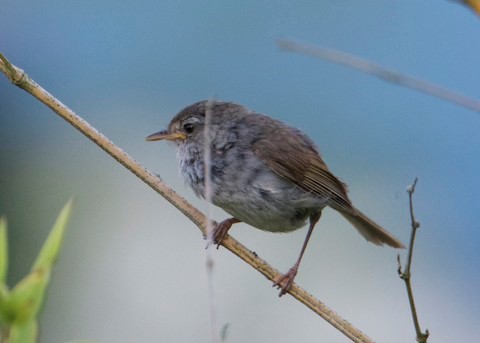
Japanese Bush-Warbler, H. d. cantans, juvenile (note traces of yellow gape) appearing mostly grayish. (Sodegaura Park, Chiba, Honshu, Japan; July 18, 2019.) © Kanayo Rolle
Cf. Manchurian Bush-Warbler. Japanese and Manchurian Bush-Warblers overlap in South Korea, Taiwan, and to some extent as migrants or vagrants to one another’s core ranges. Voice is the most reliable basis for identification, but some plumage differences may also be helpful. In general, although there is significant overlap between them, after accounting for seasonal and other variations within each species, Manchurian shows brighter, warmer tones overall and in some parts of its plumage.
Upperparts: Manchurian typically has more rufous upperparts, often especially bright on the forecrown, and sometimes uniformly warm, rusty-brown throughout. Japanese has comparatively cold-brown upperparts overall, sometimes with warmer-brown highlights on the wings, tail, and forecrown.
Facial Pattern: Japanese typically has a thin, well-defined, dark, usually blackish eyeline, which separates a thin, pale-gray eyebrow from a gray cheek. Manchurian has a blurrier, browner eyeline, which separates a buffy eyebrow from a buffy or warm-brown cheek.
Notes
Polytypic species consisting of four recognized subspecies, but its internal taxonomy and relationship with the closely related Manchurian Bush-Warbler (i.e., the potentially distinguishable subspecies borealis and canturians) remain unsettled and could be revised pending further study of their vocalizations.
References
BirdLife International. 2017. Horornis diphone (amended version of 2016 assessment). The IUCN Red List of Threatened Species 2017: e.T22714380A111072668. https://dx.doi.org/10.2305/IUCN.UK.2017-1.RLTS.T22714380A111072668.en. (Accessed September 8, 2020.)
Brazil, M. 2009. Birds of East Asia. Princeton University Press.
eBird. 2020. eBird: An online database of bird distribution and abundance. Cornell Lab of Ornithology, Ithaca, N.Y. http://www.ebird.org. (Accessed September 7, 2020.)
Pratt, H.D., P.L. Bruner, and D.G. Berrett. 1987. A Field Guide to the Birds of Hawaii and the Tropical Pacific. Princeton University Press.
Pyle, R.L., and P. Pyle. 2017. The Birds of the Hawaiian Islands: Occurrence, History, Distribution, and Status. Version 2 (January 1, 2017). http://hbs.bishopmuseum.org/birds/rlp-monograph/. B.P. Bishop Museum, Honolulu, Hawaii.
Xeno-Canto. 2020. Japanese Bush Warbler – Horornis diphone. https://www.xeno-canto.org/species/Horornis-diphone. (Accessed September 9, 2020.)

